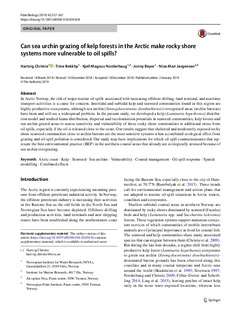Can sea urchin grazing of kelp forests in the arctic make rocky shore systems more vulnerable to oil spills?
Peer reviewed, Journal article
Published version
Date
2019Metadata
Show full item recordCollections
- Articles [3012]
- Publikasjoner fra CRIStin [3070]
Abstract
In Arctic Norway, the risk of major marine oil spills associated with increasing offshore drilling, land terminal, and maritime transport activities is a cause for concern. Intertidal and subtidal kelp and seaweed communities found in this region are highly productive ecosystems, although sea urchin (Strongylocentrotus droebachiensis)-overgrazed areas (urchin barrens) have been and still are a widespread problem. In the present study, we developed a kelp (Laminaria hyperborea) distribution model and studied fauna distribution, dispersal and recolonisation potentials in seaweed communities, kelp forests and sea urchin-grazed areas to assess sensitivity and vulnerability of these rocky shore communities to additional stress from oil spills, especially if the oil is released close to the coast. Our results suggest that sheltered and moderately exposed rocky shore seaweed communities close to urchin barrens are the most sensitive systems when a combined ecological effect from grazing and oil spill pollution is considered. Our study may have implications for which oil spill countermeasures that represent the best environmental practice (BEP) in the northern coastal areas that already are ecologically stressed because of sea urchin overgrazing.
